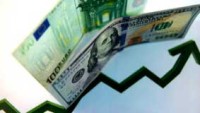 The EUR/USD lost its earlier gains on Tuesday, before dropping slightly in the first half of Wednesday’s session following the release of a weaker-than-expect German CPI report. Meanwhile, the US dollar strengthened against most other currencies, helped in part by stocks and bonds easing lower again. Attention will turn to the upcoming core PCE price index on Friday. Ahead of it, the US dollar is finding some support again
The EUR/USD lost its earlier gains on Tuesday, before dropping slightly in the first half of Wednesday’s session following the release of a weaker-than-expect German CPI report. Meanwhile, the US dollar strengthened against most other currencies, helped in part by stocks and bonds easing lower again. Attention will turn to the upcoming core PCE price index on Friday. Ahead of it, the US dollar is finding some support again
Why is the US dollar pushing higher?
This renewed dollar strength has been driven in part by a surprise rise in US consumer confidence for May and the resulting increase in US bond yields, which found additional support from weak auctions of two- and United States 5-Year Treasuries. The Fed’s ongoing hawkish tone has also been a supporting factor for the dollar. Minneapolis Fed President Neel Kashkari said policymakers haven’t entirely ruled out additional interest-rate hikes.
Such has been the strength of US dollar today that not even a higher-than-expected CPI report from Australia could help to provide lasting support for the AUD/USD pair. Here, CPI came in at 3.6% y/y, which has basically ended hopes for a Reserve Bank of Australia rate cut this year.
Bullish momentum in some currency pairs has also helped to keep the DXY supported. As well as the USD/JPY slowly grinding above 157.00, you have the offshore USD/CNH nearing the highs of the year circa 7.28, which partly explains why the AUD/USD has turned lower despite a hotter inflation report from Australia. A potential rise to a new high for the year on the USD/CNH could negatively impact risk assets and benefit the dollar.
German CPI comes in weaker
The EUR/USD is in an overall consolidation mode as investors await the release of key inflation data from both the US and the Eurozone this week. This data could provide insights into the timing of the first rate cuts by the ECB and the Fed, which have been delayed due to stronger-than-expected wage growth in the Eurozone and robust US business activity.
Ahead of the Eurozone CPI, we have seen the German inflation report come in slightly weaker today at +0.1% m/m vs. +0.2% expected. The y/y rate was in line at 2.4%, up from 2.2% previously. Eurozone inflation numbers will be release on Friday, the same day when the US Core PCE Price Index will be released.
Recent improvements in Eurozone economic data have supported the euro. Last week, better-than-expected PMI data and an unexpected rise in Eurozone wage growth for the first quarter were reported. This wage growth, driven mainly by a significant increase in Germany, could accelerate the economic recovery.
Negotiated wages in Q1 rose 4.7% year-over-year, compared to an expected drop to 4.0% from 4.5% in Q4. This situation presents a major dilemma for the ECB ahead of its June rate decision. However, judging by the just-released German CPI report, the rate cut may go ahead anyway given that the ECB has built it up so much.
EUR/USD technical analysis and trade ideas
The EUR/USD remains stuck in consolidation, unable so far to climb decisively above April’s high of 1.0885.
The underlying trend appears to be modestly bullish following the break of the bearish trend line that had been in place since December. The bulls will remain content as long as the key support around the 1.0800 area holds.

Short-term resistance is at 1.0885-95, which held after this week’s earlier test. Here, the EUR/USD topped in April and found resistance in the last couple of weeks. A clean breakout above here could pave the way for a potential rise toward the March high of 1.0981 and subsequently the 1.10 handle.












